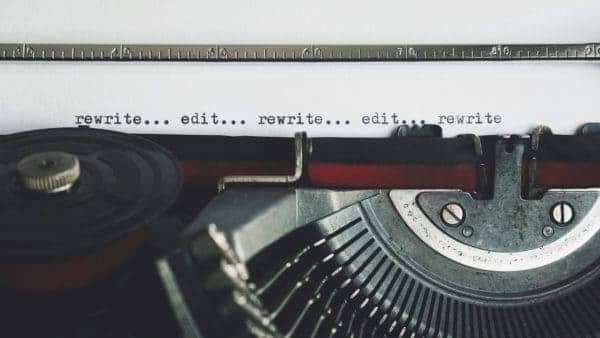So, you’ve finished your first draft and getting ready to query literary agents or self-publish your masterpiece. But not so fast. As great as you think your draft is, it needs further revisions. Editing your story may not be the most fun part of writing, especially when you’re re-reading your story for the nth time but it’s a necessary evil.
There’s no right or wrong way to self-edit your story, so do whatever works for you however you might find the process I used for my own novel, Broken, helpful to you.
1. Congratulate and give yourself a break

There is a method to the madness of this point because time away from writing will give you time to forget about your novel for a while, so when you come back to it, your eyes will be a little fresher and perhaps more objective. So, give yourself a break, get back to your life again, watch that true crime Netflix documentary that you put on the back burner, or simply soak up your well-deserved break.
The amount of rest time you should take depends on you but it should be long enough for your mind not to be buried in details of your story. I took about a week off after finishing my manuscript, but I probably could have done with longer. If you are anxious about letting your book rest and therefore “waste time”, the writing process doesn’t stop just because you stopped writing. For instance, you can get feedback on your book, think about your next story, read other books, learn more about the writing craft, or just spend more time with your family. These will all help with your writing goals.
2. Start with the big picture
Start with the big picture before homing in on the details as there is no point perfecting line level prose if you are going to delete or modify it later. Big picture means developmental edits, ensuring no major plot holes, sound structure, appropriate pacing, world building, and character development, etc.
2.1 – Writing an outline to identify major development areas
To identify if there are major plot holes, I found writing an outline useful. It doesn’t need to be detailed, just enough for you to get a sense of the overall storyline on a few pages so you don’t have to flick through your manuscript, which may side track you or make you lose your place in your process. It should simply have a few sentences on the purpose of the chapter, scene, the conflict, and outcome.
When you have a good handle on the overall shape of your story, ask yourself if your story is hitting key milestones. E.g., does the inciting incident happen at the right place? Is the story heading in the direction you intended? Is the pacing sufficient? Are the arcs of the characters sufficiently developed? Be honest with your answers and don’t brush over any deficiencies simply because it would be too time consuming to change the chapter or too inconvenient to open that can of worms. Your readers will thank you for it later.
2.2 – Categorise areas for improvement and have a plan for the revisions
When you’ve identified the areas for improvement, list them into categories, such as character arc, plot holes, or continuity errors. But before you dive into making changes willy nilly, step back and think them through. Brainstorm how you’re going to fix the issues. It’s tempting to simply fix the superficial because you want to finish your finalised your edits ASAP so the world can see how great a story you have but use this opportunity to as the “what if” question. I.e., what if the character finds out a secret earlier instead of later, what if the main character faces an unexpected set back? What if you inject unexpected humour in places?
2.3 – Revise your outline
So, if you’ve written an outline, revise it instead of diving straight into revising your manuscript because that what you change in one scene may impact other chapters. The character’s backstory might change, the path that they end up choosing might be different, or they may have different motivations for picking the same choice. This domino effect is what makes editing such a headache – at least for me! It will also give you an opportunity to assess how strong the revised outline before spending hours on the edits.
3. How should you tackle your edits?
When you’re ready to start making your revisions, you can either work in sequence, chapter by chapter, or tackle the biggest issues first. I found the latter more productive for me because although I had a revised outline, it was only a high level sketch and sometimes when I’d fill in the details, it might have necessitated changes in other chapters but it made sure I had the key beats in the story.
If you choose this method, you’ll need to go through your story from start to end to make sure that any plot holes are addressed, the story still flows, there are no continuity or pacing issues, and there is sufficient foreshadowing, etc.
4. How will you know the edits you’re making are right?
Without knowing your story, it’s hard to say but for me, I ask myself four things:
- How does this progress the story? If a scene or chapter doesn’t move the story towards key plot points or reveal something about a character, you probably can do away with the revision.
- How does this develop the character? The development of a character should be continuous. If the revisions does not show anything new about the character, you probably need to think harder about the revisions you’re making.
- How engaging is the scene? Is there sufficient conflict in the scene or is it filler? This might seem obvious – and it should be – but sometimes it is tempting to force-fit a joke that you really want to tell, or leave a boring scene in because you spent hours on it.
- Other questions to ask are: are you bored of your own writing? Did the original intention of the scene make it onto the page? And did you foreshadow enough for the revisions to make an impact?
5. How long will self-editing take?
There is no standard answer for it as it depends on the extent of the revisions required and how much experience you have at editing your work. Therefore, it could take days, weeks or months. But don’t be too hung up on how long it takes. The most important thing is to make the edits your manuscript needs so it can be as good as possible.
If you’re new to writing, you may not know how much time revisions will take. Again, don’t worry too much about it. Simply start and get a feel for your pace. When you have established a rhythm, set timelines and adjust them accordingly. For my writing, I have daily, weekly, and monthly goals. I don’t strictly hit these goals every single time but by having a general direction, I know that I’ll make incremental progress and my manuscript will be completed soon enough.







